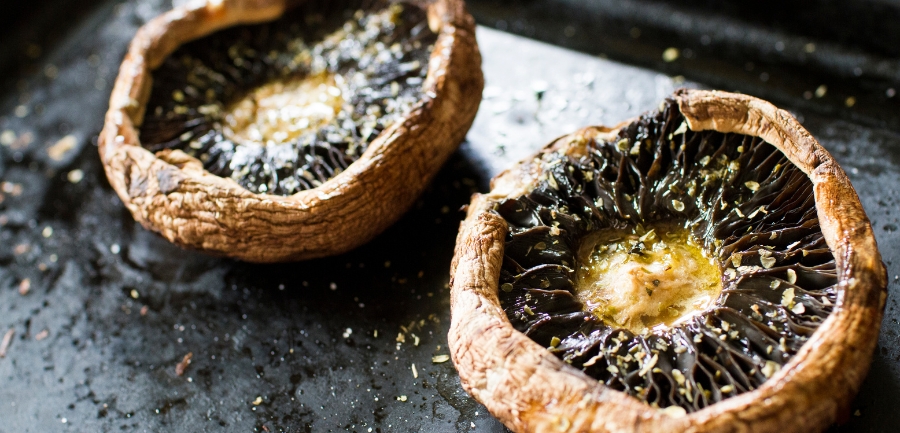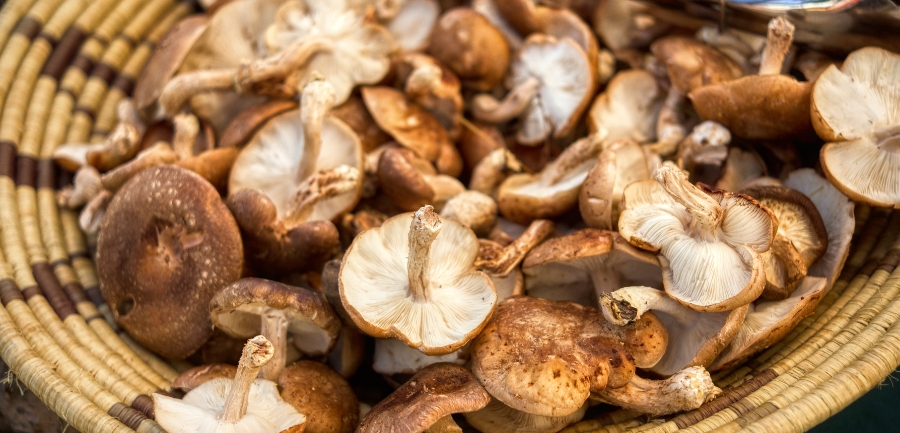Hey there, fellow food enthusiasts! So, we all love a good portobello mushroom, right? That meaty texture, that earthy taste – pure bliss on a plate. And while they’re a super addition to any meal with all those awesome nutrients, there’s a little more to these fungi than meets the eye.
Table of Contents
Ever picked up a portobello and wondered about the dirt? Yep, if not handled just right, they could be partying with some not-so-friendly bacteria. But, no stress! A good rinse and you’re back in business.
And here’s a little tidbit: agaritine. Sounds fancy, but it’s just a compound in Portobellos. Research is still in the works, but moderation seems to be the buzzword here.
So, here’s the deal: get to know your foods, and you’ll always be one step ahead. Portobellos? Still a win in my book. Just gotta treat them right!
What Are the Negative Effects of Portobello Mushrooms?

Alright, let’s dive in, shall we? We’ve sung praises about the portobello, but let’s not shy away from some of the not-so-glam parts. Don’t get me wrong, I’m not here to rain on the Portobello parade, but a little info never hurt anyone.
Portobello Mushroom Dangers
- Risks of Contamination: Bacteria and Pesticides
Hey, nature’s awesome, but it’s not always neat and clean. Mushrooms grow in soil, which means they can sometimes bring along unwanted guests like bacteria or even pesticides. It’s not about being paranoid; it’s about being proactive. A good wash and being selective about where you source your mushrooms can keep those worries at bay. - The Reality of Allergic Reactions
Fun fact: Some folks are allergic to mushrooms. Shocking, I know. If you find yourself itching, swelling, or showing any other allergic symptoms after a portobello feast, it might be time to chat with your doctor. - Potential for Medication Interactions
Mushrooms and meds are not always the best mix. Some people have found that portobellos interfere with their medication. Always good to keep that in mind and maybe have a word with your pharmacist.
Portobello Mushroom Side Effects
- Gastrointestinal Troubles and Discomfort
Love them as we might, for some, portobellos can be a bit…well, upsetting. I mean, in the tummy region. If you’re getting an upset stomach or any other GI symptoms post-mushroom meal, maybe ease up a bit. - The Double-Edged Sword of Nutrient Inhibition
Portobellos have this knack for inhibiting the absorption of certain nutrients. It’s like they’re playing hard to get with your body’s vitamins. Kind of a bummer, but again, moderation’s the key. - Agaritine: What It Is and Why It Matters
Back to our fancy word, agaritine. It’s a compound in portobellos that’s got some researchers scratching their heads. While they figure it out, we might want to think about not making every meal a mushroom fest.
The Misunderstood Concept of Negative Benefits
Let’s tackle a quirky term: negative benefits. Sounds weird, right? But hang tight; it’s a wild ride!
What Are the Negative Benefits of Portobello Mushrooms?

- Benefits Gone Awry: When Too Much Becomes Harmful
Think of your favorite dessert. A slice? Yum! The whole cake? Tummy ache. Portobellos are kind of the same. They’re packed with goodness, but overdo it, and you might not feel so great. - Balancing Nutritional Intake: Why Moderation is Key
Imagine only listening to one song on repeat. Gets old, right? Our diets need variety just like our playlists. Portobellos? Awesome! But mix it up with other veggies to keep things balanced.
Handling and Consuming Portobellos Safely
So, you’re armed with all this knowledge about portobellos. What next? Well, let’s chat about keeping things safe in the kitchen. After all, we want to enjoy our meals, not fret over them!
Ensuring Safe Preparation

- Importance of Thorough Cleaning
Dirt and debris naturally cling to the mushroom’s gills and cap. Before you cook, give them a gentle rinse under cold running water and pat them dry. If they’re especially gritty, you can use a soft brush or damp cloth to wipe them down. Remember, the goal is clean but not waterlogged! - Cooking Portobellos to Perfection
The key to unlocking a portobello’s full flavor and safety is proper cooking. Aim for a golden-brown sear if you’re sautéing. Grilling? Let them get those nice char marks. A fully cooked mushroom not only tastes better but also ensures any potential harmful microbes are history.
Storage Practices to Reduce Risks
- Proper Storage to Avoid Contamination
After shopping, don’t just toss them in the fridge. Place your portobellos in a paper bag; it helps absorb excess moisture and keeps them fresher. Store this bag in the refrigerator’s main compartment, away from strong-smelling foods. Why? Mushrooms can absorb odors, and no one wants garlic-flavored portobellos unless it’s intentional! - Shelf Life: When to Consume and When to Discard
Fresh portobellos usually last about 7-10 days in the fridge. However, if you notice they start to develop dark spots, become overly slimy, or emit a sour odor, it’s time to bid them farewell. If you’ve cooked them, aim to eat the dish within 3-4 days for best taste and safety.
Navigating the Mushroom World with Caution
Stepping into the mushroom realm feels a bit like entering a magical forest. Each variety has its own charm, flavors, and quirks. While portobellos are our main star today, it’s worth glancing at the broader mushroom spectrum and seeing how our favorite fungi measure up.
Comparing Portobellos with Other Mushrooms
How Portobellos Stand Out
- Maturity: Portobellos are the fully grown versions of crimini mushrooms. Think of them as the wise old trees in the mushroom forest.
- Texture & Use: Their thick and meaty texture makes them ideal for replacing meats. For instance, a grilled portobello can be a hearty centerpiece in a burger, providing a satisfying bite without the beef.
- Flavor: They have a distinct earthy flavor, deeper than many of their mushroom counterparts.
- Versatility: Thanks to their size, they can be creatively stuffed with ingredients like cheese, veggies, or grains, creating a delicious, wholesome meal.
Considering Alternatives: Shiitake, Oyster, and More
- Shiitake Mushrooms:

- Flavor: They offer a unique smoky taste, quite different from the deep earthiness of portobellos.
- Use: Often found in dishes like ramen or stir-fries. For a concrete example, consider a miso soup enriched with shiitake slices, absorbing that umami broth.
- Health Boost: They are believed to have immune-boosting properties. A cup of shiitake-infused tea isn’t just warm but might also give your immune system a little nudge.
- Oyster Mushrooms:

- Flavor: They come with a hint of sweetness, a departure from the robustness of portobellos.
- Texture: Their tender, velvety feel makes them melt in the mouth when cooked right.
- Use: Imagine them lightly sautéed in butter and garlic, then tossed over pasta. A simple dish that lets their delicate flavor shine.
Variety is Key
Switching between different mushrooms ensures your taste buds stay excited and your body gets a mix of nutrients. Today a portobello burger, tomorrow a shiitake stir-fry, and maybe an oyster mushroom omelette for the weekend brunch?
To Wrap It Up!
As we journey through the captivating world of portobello mushrooms, it’s evident that they’re more than just a culinary treat. From their undeniable versatility in the kitchen to the need for cautious handling, there’s a wealth of knowledge to digest. And while they stand tall and proud in the mushroom family, remember to also give a nod to their fungal cousins, each bringing its own flavor and flair to the table. In the end, it’s all about enjoying the diverse bounty nature offers, while staying informed and safe. Happy mushrooming!
FAQs
Are portobello mushrooms good or bad for you?
Portobello mushrooms are nutritious, offering vitamins and minerals. However, like any food, they should be consumed in moderation and properly prepared to ensure safety.
What happens if you eat too much portobello mushrooms?
Overconsumption might lead to gastrointestinal discomfort. Some compounds in mushrooms, if eaten excessively, can potentially interfere with nutrient absorption.
Are raw portobello mushrooms safe?
While often safe, raw portobellos may harbor bacteria. It’s advisable to cook them to eliminate potential pathogens and reduce certain compounds.
When should you not eat portobello mushrooms?
Avoid portobellos if they’re slimy, have an off odor, or show signs of decay. These are indicators they’ve passed their prime and might not be safe.
Is it OK to eat portobello mushrooms every day?
Eating them daily in moderate amounts is generally safe. However, diversifying one’s diet ensures a broader nutrient intake and reduces overexposure to specific compounds.

